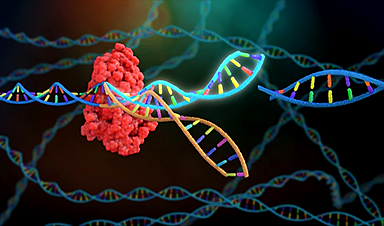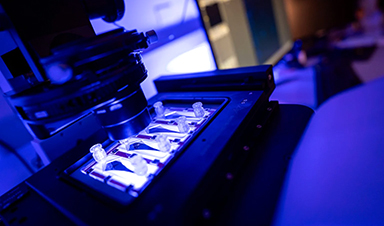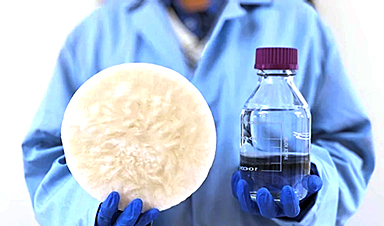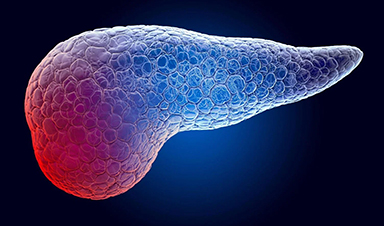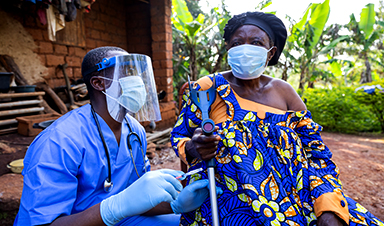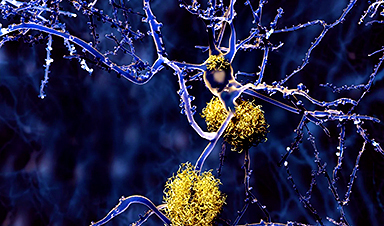“It is a very serious disease with serious complications from which patients die relatively young,” says hematologist Linet Njue, senior physician at Inselspital Bern. According to the doctor, around 100 patients with the disease are being treated in large university hospitals in Switzerland, but the exact number is not recorded. It is one of the most common hereditary diseases worldwide.
The disease is caused by a gene that carries the blueprint for the red blood pigment haemoglobin. A gene mutation crystallizes the hemoglobin, causing the normally round red blood cells to deform into sickles. These, in turn, clog the bloodstream.
Now, the UK Medicines Agency has given the green light for a new gene therapy for sickle cell anaemia patients aged 12 and over. It is called Exacel (brand name “Casgevy”) and was developed by the companies Vertex Pharmaceuticals and CRISPR Therapeutics, the latter based in Zug.
It is the first ever approved treatment based on the CRISPR/Cas9 gene scissors. This is the technology that can precisely cut through and modify the genetic material and for the discovery of which the Nobel Prize in Chemistry was awarded in 2020.
No need for a foreign donor anymore
Victoria Gray, now 37, was the first person to be treated with the therapy in 2019. Thanks to the new “supercells”, her life has changed completely, she recently said. She now lives free of pain, can go back to work and take care of her four children.
Exacel has now been tested on around forty sickle cell anemia patients. As Vertex Pharmaceuticals and CRISPR Therapeutics have announced, additional clinical trials with children between the ages of 2 and 11 are now to begin. An application for approval for the therapy has not yet been received from the companies in Switzerland, as Swissmedic confirmed on request.
How Exacel Therapy WorksExacel does not target the disease-causing and mutated HBB gene, which causes the sickle-shaped blood cells. Rather, the therapy is dedicated to the gene called BCL11A. This gene is activated at birth and thus inhibits the formation of haemoglobin, which is actually only produced in the fetus. Exacel then cuts BCL11A apart, which deactivates the gene again and resumes prenatal hemoglobin production. This provides additional hemoglobin that is not malformed. The symptoms of the disease disappear. (sny)
Jacob Corn is Professor of Genome Biology at ETH Zurich and has been working on CRISPR treatments for years, including for sickle cell disease. “The whole CRISPR community is in a frenzy. The Exacel successes are impressive,” he says.
Nevertheless, it is crucial to accompany the treated patients over a long period of time, the regulatory authorities require at least 15 years. This is the only way to rule out long-term side effects, such as an increased risk of blood cancer – a concern that worries some scientists. However, Corn emphasizes: “At the moment, things are looking really good.”
According to the ETH professor, the CRISPR gene scissors offer a gateway to a new world of medicine. He draws a comparison:
It’s the same with hereditary diseases so far: You can make a genetic diagnosis to suffering patients, but you can’t offer them a therapy – that’s changing now.
There are more than 7000,1 diseases that are based on a single gene mutation, such as sickle cell anemia, and dozens of therapies are already in the pipeline, for example against the metabolic disease called familial hypercholesterolemia, which affects about 200 in <> people in Switzerland.
Due to the disease, a dangerous amount of cholesterol always remains in the blood. This greatly increases the risk of a heart attack or stroke. Studies with the CRISPR therapy from the biotech company Verve Therapeutics have so far been promising, even suggesting that “the world’s biggest killer” can soon be stopped, according to the headline of the US magazine “MIT Technology Review”.
Targeting multiple genes is much more difficult
Other diseases in the focus of the genetic engineers are cystic fibrosis, Duchenne muscular dystrophy or progeria, in which affected children age as if in fast motion. In addition to these single-mutation diseases, there are countless other diseases that are based on a combination of several gene mutations and environmental factors: Alzheimer’s, arthritis, many cancers, diabetes, autism spectrum disorders are just a few examples.
Another hurdle of future CRISPR therapies is those diseases that affect organs that are difficult to reach. In sickle cell anemia, it is comparatively easy to extract the blood cells from the body, manipulate them and return them. “In cystic fibrosis, on the other hand, where the lungs are damaged, it is a much more difficult procedure to get the genetic medicine to the right place,” says Corn.
The high cost could limit availability
Geneticists are very worried about the horrendous costs, which are estimated to run into the millions for a single CRISPR treatment. It is questionable whether poorer countries can afford such therapies. Even rich countries get into trouble when a large number of patients suddenly want to be treated.
One dilemma, according to Jacob Corn, is that the safety requirements imposed by the health authorities are enormously high – and therefore costly. “That’s good, because it must be guaranteed that the therapies do no more harm than good.” The hope is that after the first approvals, the multitude of safety and efficacy tests will no longer have to be carried out every single time. “If the safety of CRISPR technology is proven on its own, then hopefully it would be legitimate to accelerate the testing and approval of therapies for other diseases,” says Corn.
Another approach: Instead of isolating the cells for the gene changes, treating them and then injecting them back into the body, researchers are tinkering with a gene injection: “The idea is that the genome editing process is injected into the body, so to speak, where it finds the right place and exerts its effect.” This would not only make treatment cheaper, but also more accessible, for example in regions of Africa where there are few health facilities. No tests have yet been carried out in humans, only in animals.
But Jacob Corn is confident: “A large number of research groups around the world are involved in CRISPR. How quickly things can sometimes happen when many bright minds are working on a problem at the same time was seen with the Corona vaccination.” (aargauerzeitung.ch)
News
Tumor “Stickiness” – Scientists Develop Potential New Way To Predict Cancer’s Spread
UC San Diego researchers have developed a device that predicts breast cancer aggressiveness by measuring tumor cell adhesion. Weakly adherent cells indicate a higher risk of metastasis, especially in early-stage DCIS. This innovation could [...]
Scientists Just Watched Atoms Move for the First Time Using AI
Scientists have developed a groundbreaking AI-driven technique that reveals the hidden movements of nanoparticles, essential in materials science, pharmaceuticals, and electronics. By integrating artificial intelligence with electron microscopy, researchers can now visualize atomic-level changes that were [...]
Scientists Sound Alarm: “Safe” Antibiotic Has Led to an Almost Untreatable Superbug
A recent study reveals that an antibiotic used for liver disease patients may increase their risk of contracting a dangerous superbug. An international team of researchers has discovered that rifaximin, a commonly prescribed antibiotic [...]
Scientists Discover Natural Compound That Stops Cancer Progression
A discovery led by OHSU was made possible by years of study conducted by University of Portland undergraduates. Scientists have discovered a natural compound that can halt a key process involved in the progression [...]
Scientists Just Discovered an RNA That Repairs DNA Damage – And It’s a Game-Changer
Our DNA is constantly under threat — from cell division errors to external factors like sunlight and smoking. Fortunately, cells have intricate repair mechanisms to counteract this damage. Scientists have uncovered a surprising role played by [...]
What Scientists Just Discovered About COVID-19’s Hidden Death Toll
COVID-19 didn’t just claim lives directly—it reshaped mortality patterns worldwide. A major international study found that life expectancy plummeted across most of the 24 analyzed countries, with additional deaths from cardiovascular disease, substance abuse, and mental [...]
Self-Propelled Nanoparticles Improve Immunotherapy for Non-Invasive Bladder Cancer
A study led by Pohang University of Science and Technology (POSTECH) and the Institute for Bioengineering of Catalonia (IBEC) in South Korea details the creation of urea-powered nanomotors that enhance immunotherapy for bladder cancer. The nanomotors [...]
Scientists Develop New System That Produces Drinking Water From Thin Air
UT Austin researchers have developed a biodegradable, biomass-based hydrogel that efficiently extracts drinkable water from the air, offering a scalable, sustainable solution for water access in off-grid communities, emergency relief, and agriculture. Discarded food [...]
AI Unveils Hidden Nanoparticles – A Breakthrough in Early Disease Detection
Deep Nanometry (DNM) is an innovative technique combining high-speed optical detection with AI-driven noise reduction, allowing researchers to find rare nanoparticles like extracellular vesicles (EVs). Since EVs play a role in disease detection, DNM [...]
Inhalable nanoparticles could help treat chronic lung disease
Nanoparticles designed to release antibiotics deep inside the lungs reduced inflammation and improved lung function in mice with symptoms of chronic obstructive pulmonary disease By Grace Wade Delivering medication to the lungs with inhalable nanoparticles [...]
New MRI Study Uncovers Hidden Lung Abnormalities in Children With Long COVID
Long COVID is more than just lingering symptoms—it may have a hidden biological basis that standard medical tests fail to detect. A groundbreaking study using advanced MRI technology has uncovered significant lung abnormalities in [...]
AI Struggles with Abstract Thought: Study Reveals GPT-4’s Limits
While GPT-4 performs well in structured reasoning tasks, a new study shows that its ability to adapt to variations is weak—suggesting AI still lacks true abstract understanding and flexibility in decision-making. Artificial Intelligence (AI), [...]
Turning Off Nerve Signals: Scientists Develop Promising New Pancreatic Cancer Treatment
Pancreatic cancer reprograms nerve cells to fuel its growth, but blocking these connections can shrink tumors and boost treatment effectiveness. Pancreatic cancer is closely linked to the nervous system, according to researchers from the [...]
New human antibody shows promise for Ebola virus treatment
New research led by scientists at La Jolla Institute for Immunology (LJI) reveals the workings of a human antibody called mAb 3A6, which may prove to be an important component for Ebola virus therapeutics. [...]
Early Alzheimer’s Detection Test – Years Before Symptoms Appear
A new biomarker test can detect early-stage tau protein clumping up to a decade before it appears on brain scans, improving early Alzheimer’s diagnosis. Unlike amyloid-beta, tau neurofibrillary tangles are directly linked to cognitive decline. Years [...]
New mpox variant can spread rapidly across borders
International researchers, including from DTU National Food Institute, warn that the ongoing mpox outbreak in the Democratic Republic of the Congo (DRC) has the potential to spread across borders more rapidly. The mpox virus [...]
